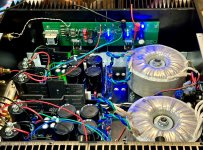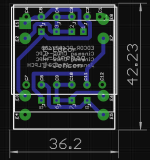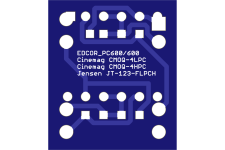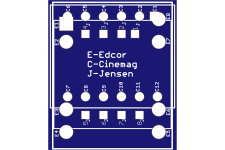Thanks again TA, as I have some time before the build, I will check the transistors and see how they match - will do the same for my tube of FQH44N10 Mosfets. Will test at 1 amp and match Vgs as per the NP mosfet test document.
Last edited:
Your amp will be very special 😉
I am looking forward to seeing how the various builds turn out.
I am looking forward to seeing how the various builds turn out.
I have a tube of 25 Mosfets (FQH's), just had a look at them, and there seems to be 2 different batch codes, so will see how close they match.
A dreary day here yesterday, so I tested my tube of 25 On Semi (Fairchild) FGH44N10 Mosfets. It is a pity these things are still not around. I got mine a few years ago when I read about how good they were on one of the forum posts. I think from memory, they were end of life back then.
First, they all tested in spec – so no duds. I wanted to test them at 1 Amp but did not have a suitable load resistor using the Nelson Pass test circuit that has been around for years. I had a 25R 30W resistor, which gave me a drain current of 420mA (Nelson tests at 170mA for output devices using a 56R resistor with a 15VDC supply).
I tested each device clamped to a heatsink for 2 minutes, although the Vgs settled in about 10 seconds, then recorded each Vgs figure.
Over the 25 devices, the minimum measured Vgs was 3.860VDc and the maximum was 3.946VDC- the datasheet says this figure should be between 2 and 4VDC.
So, out of the 25 tested, I got 9 perfectly matched pairs to the mV and three more pairs within 1mV to 4mV difference – well within what Nelson accepts.
Pair1 = 3.903Vgs
Pair2 = 3.906Vgs
Pair3 = 3.911Vgs
Pair4 = 3.914Vgs
Pair5 = 3.918Vgs
Pair6 = 3.920Vgs
Pair7 = 3.924Vgs
Pair8= 3.931Vgs
Pair9= 3.941Vgs
Pair10 = 3.902 and 3.903Vgs
Pair11 = 3.925 and 3.927Vgs
Pair12 = 3.942 and 3.946Vgs
So far the parameters Nelson uses, this makes 12 perfectly matched pairs out of 25 devices. The final device had a Vgs of 3.860. These were way more consistent than other devices of this size by IR/Vishay. Nelson says matching output devices within 200mV will work and 100mV is much better - so these results are perfect.
First, they all tested in spec – so no duds. I wanted to test them at 1 Amp but did not have a suitable load resistor using the Nelson Pass test circuit that has been around for years. I had a 25R 30W resistor, which gave me a drain current of 420mA (Nelson tests at 170mA for output devices using a 56R resistor with a 15VDC supply).
I tested each device clamped to a heatsink for 2 minutes, although the Vgs settled in about 10 seconds, then recorded each Vgs figure.
Over the 25 devices, the minimum measured Vgs was 3.860VDc and the maximum was 3.946VDC- the datasheet says this figure should be between 2 and 4VDC.
So, out of the 25 tested, I got 9 perfectly matched pairs to the mV and three more pairs within 1mV to 4mV difference – well within what Nelson accepts.
Pair1 = 3.903Vgs
Pair2 = 3.906Vgs
Pair3 = 3.911Vgs
Pair4 = 3.914Vgs
Pair5 = 3.918Vgs
Pair6 = 3.920Vgs
Pair7 = 3.924Vgs
Pair8= 3.931Vgs
Pair9= 3.941Vgs
Pair10 = 3.902 and 3.903Vgs
Pair11 = 3.925 and 3.927Vgs
Pair12 = 3.942 and 3.946Vgs
So far the parameters Nelson uses, this makes 12 perfectly matched pairs out of 25 devices. The final device had a Vgs of 3.860. These were way more consistent than other devices of this size by IR/Vishay. Nelson says matching output devices within 200mV will work and 100mV is much better - so these results are perfect.
Last edited:
More than just pairs, you have some really great matched quads.
I have been curious about what an Aleph J would sound like with the FQH44N10. You have the parts to make that happen.
I have been curious about what an Aleph J would sound like with the FQH44N10. You have the parts to make that happen.
Based on Nelson's matching criteria, then they are just about all matched quads, with only 43mV between highest and lowest Vgs figure over the 24 devices.
^ Certainly, if you are fortunate to have some of the power JFets, they will work equally well in the new PCBs. You may need to make some component changes, such as reducing the Source resistors to 0.1 Ohm instead of 0.47 Ohms. You may also only need two green LEDs in series instead of three. I trust you can figure out how to wire around the third LED location in the board if that is necessary.
Jensen JT-123-FLPCH is not available in UK, even on eBay. Can you please suggest an alternative?
Thanks
Thanks
The new PCBs only support the Jensen footprint. There is no other signal transformer that has the same pin locations. If you can manage to build your own mezzanine board to convert from the Jensen pinout to something else, then I recommend the CineMag CMOQ-4LPC or CMOQ-4HPC.
I have been listening to a second build of the F6 Diamond PCBs with IXTQ75N10P Mosfets for the last couple days. Yes, I have been taking my sweet time. Or as Pa likes to say:

Good news! These parts sound equally great in the F6 as the FQH44N10. With a variety of music styles, the sound remains dynamic, clear and articulate. In my dual-mono chassis, the soundstage was immense and individual instruments often had a spooky 3D presence.
The IXTQ75N10P is a high transconductance and high power Mosfet that is easy to drive, with reasonable input capacitance and low total gate charge. It responds well to higher power rail voltage and bias current, but its datasheet specs indicate that the standard F6 voltages and bias currents should also work well. The threshold voltage is higher than the typical IRFP standard (or the FQH for that matter). This is easy to manage with the new F6 PCBs by substituting one blue LED for a green in each string. This provides an extra volt for setting Vgs to achieve the desired bias current. My boards settled in easily at 1.75A bias and offset < 10 mV.
I recommend using these parts if you are curious what high transconductance output devices can do for the F6.

Good news! These parts sound equally great in the F6 as the FQH44N10. With a variety of music styles, the sound remains dynamic, clear and articulate. In my dual-mono chassis, the soundstage was immense and individual instruments often had a spooky 3D presence.
The IXTQ75N10P is a high transconductance and high power Mosfet that is easy to drive, with reasonable input capacitance and low total gate charge. It responds well to higher power rail voltage and bias current, but its datasheet specs indicate that the standard F6 voltages and bias currents should also work well. The threshold voltage is higher than the typical IRFP standard (or the FQH for that matter). This is easy to manage with the new F6 PCBs by substituting one blue LED for a green in each string. This provides an extra volt for setting Vgs to achieve the desired bias current. My boards settled in easily at 1.75A bias and offset < 10 mV.
I recommend using these parts if you are curious what high transconductance output devices can do for the F6.
Attachments
Thanks again TA, for those impressions. My build will start in the New Year - have all parts in hand now - dual mono like yours.
I have been very happy with the Cinemag transformers, and they are less expensive and available.
I used them in the SIT 3 and other projects.

I used them in the SIT 3 and other projects.

Great findings and thanks for sharing @TungstenAudio !
Side-lateral questions.. which - if any still available - N-channel TO-3 power transistors would work well in the F6? Did anyone build such an F6?
Happened to briefly read that maybe the lateral 2SK135 might fit? (these are not readily available but happen to have four around.. I would use them in a TO-3 drilled chassis..)
Side-lateral questions.. which - if any still available - N-channel TO-3 power transistors would work well in the F6? Did anyone build such an F6?
Happened to briefly read that maybe the lateral 2SK135 might fit? (these are not readily available but happen to have four around.. I would use them in a TO-3 drilled chassis..)
I haven't done much research on the older lateral TO-3 Mosfets. I do have a few sets that I pulled from old Hafler DH-200 and DH-220 chassis, where they were used in matched pairs. The larger Hafler amps used matched triples or quads to increase power handling. For their day, the Hafler amplifiers were well regarded, and some of the early DIY friendly designs that allowed audio enthusiasts to save money by doing final wiring and assembly. I built my DH-220 in the summer of 1982 and it served me well until I eventually got my first Naim system in 1990.
The 2SK135 transistors to my knowledge have not been used in many, if any, class A applications. They might be worth a try in a basic +/– 23V F6 build with the bias current kept at 1.05 Amp, the starting point that 6L6 uses in his Illustrated F6 guide. No point in frying these venerable devices with too much current. The existing F6 PCBs do not make it easy to add more output devices in parallel. There may be some Exicon laterals available if one is lucky; some of their parts were effectively two 2SK135 in a single TO-3 case.
The 2SK135 transistors to my knowledge have not been used in many, if any, class A applications. They might be worth a try in a basic +/– 23V F6 build with the bias current kept at 1.05 Amp, the starting point that 6L6 uses in his Illustrated F6 guide. No point in frying these venerable devices with too much current. The existing F6 PCBs do not make it easy to add more output devices in parallel. There may be some Exicon laterals available if one is lucky; some of their parts were effectively two 2SK135 in a single TO-3 case.
I recommend the CineMag CMOQ-4LPC or CMOQ-4HPC
Could you comment on the differences, if any, between the Jensen and Cinemag transformers?
I have not done a direct comparison between the Jensen and the CineMag transformers. They are both quad-filar with four equal windings wound onto the same core, and both are intended for the highest audio performance applications. I suspect differences will be a matter of personal preference.
Mighty ZenMod has the ability to use three (Jensen, Edcore and Cinemag ) transformers on some of his boards.
Would it be possible for someone (not me) to design and possibly make a daughter board to plug into the store F6 board to allow the use of the other similar transformers?
Would it be possible for someone (not me) to design and possibly make a daughter board to plug into the store F6 board to allow the use of the other similar transformers?
Attachments
- Home
- Amplifiers
- Pass Labs
- The F6 Revisited





